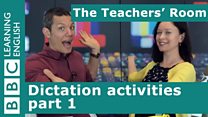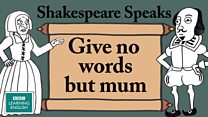Unit 11: English You Need
Exams, news, pronunciation, teachers' tips, learners' questions
Select a unit
- 1 English You Need
- 2 English You Need
- 3 English You Need
- 4 English You Need
- 5 English You Need
- 6 English You Need
- 7 English You Need
- 8 English You Need
- 9 English You Need
- 10 English You Need
- 11 English You Need
- 12 English You Need
- 13 English You Need
- 14 English You Need
- 15 English You Need
- 16 English You Need
- 17 English You Need
- 18 English You Need
- 19 English You Need
- 20 English You Need
- 21 English You Need
- 22 English You Need
- 23 English You Need
- 24 English You Need
- 25 English You Need
- 26 English You Need
- 27 English You Need
- 28 English You Need
- 29 English You Need
- 30 English You Need
Session 4
Welcome to The Teachers’ Room. The show all about teaching practice. Grab a cup of coffee, pull up an armchair and relax. Learn something new, remember something fundamental or just have a giggle.
Activity 1
The Teachers' Room
Dictation activities part 2
Dan and Sian discuss more ways to make dictation enjoyable for students
Watch the video and complete the activity

___________________________________________________________________
Did you like that? Why not try these?
____________________________________________________________________________________
Dictation activities: part 2
Dictactions have been a part of the EFL teacher's arsenal since teaching began! They are a great way of getting students to utilise multiple language skills: listening, reading, writing, speaking, pronunciation, grammar and vocabulary understanding... it's all there! And the good news is: dictation doesn't have to be boring!
Whispering chain dictation
This activity is famous for being difficult. The target language going in is not usually the language which emerges, which makes it great for peer correction as an after activity. Have the students work in groups and stand in a line. Communicate the target language to the first student in each line, who must whisper it to the person next to them. The target language is passed down the line until the learner at the end records it on paper. Then have them switch places.
Back to back dictation
This is a nice activity for emulating phone conversations or any situation where learners may not be able to see each other face to face. Quite simply, give learners a split text to communicate and have them sit back to back. They are not allowed to turn around or attempt to see their partner. They must then work together to complete the text.
Picture dictation
These are perfect for practising things like prepositions, directions, adjectives and descriptions of things – it all depends on the picture. Give one student a picture and have them describe it to their partner, who is not allowed to see it directly. Their partner must draw it as accurately as possible.
Young learners picture dictation
This is useful for teaching human body vocabulary. After introducing the vocabulary, give the learners a piece of paper and ask them to draw the body parts that you name. Feel free to make the drawings unusual e.g. three legs! Get them to draw a monster, which can be coloured in later and they can practice speaking by describing what they have drawn.
To do
Try our quiz to see if you've picked up our tips.
The Teachers' Room Quiz
3 Questions
Check what you've learned about dictation activities by selecting the correct answer to each question.
Help
Activity
Check what you've learned about dictation activities by selecting the correct answer to each question.
Hint
Directions can be quite complicated and may take the form of a series of sentences rather than just one. Which of these dictations would make this difficult?Question 1 of 3
Help
Activity
Check what you've learned about dictation activities by selecting the correct answer to each question.
Hint
If learners sit back to back in a room, especially one where many people are also speaking, how could this be difficult?Question 2 of 3
Help
Activity
Check what you've learned about dictation activities by selecting the correct answer to each question.
Hint
Whispering chain dictations almost always result in the slight changing of the original message. So what happens when they have the finished with the incorrect message?Question 3 of 3
Excellent! Great job! Bad luck! You scored:
Get involved
Well, those were just a few ideas that we here at BBC Learning English had, but we know that you teachers out there have lots of fantastic ideas too, and we’d like you to share them with us and everybody else.
If you have a great tip or technique for teaching dictation, or anything else, please email us at learningenglish@bbc.co.uk. Your email could be posted here on this page, or may even be mentioned in our show.
We are also looking for video tips to include in the programme. In order to do this, please include whether or not you’d like to be included for video with your tip, and we'll get in touch with you.
Ekaterina, Russia
I usually start my class by introducing myself, but this is not a boring "Hi! My name is Kate. I'll be your teacher." Never. I make a colourful computer presentation with my personal photos. The fact that it's visual allows me to use it with students of any level. I try to include some amusing personal facts to make them relaxed and, at the same time, I also stress my achievements to get their respect. Besides, only on this first class I let them ask me ANY questions they like (only in English, of course). They always get very excited about finding some hidden facts about their teacher and suddenly realise they remember many English words :) This introduction helps me to create friendly atmosphere in class, make them see me as a usual person with her own family, hobbies, good and bad sides, but not as a class monster going to torture them)) however, letting my students do this only on the first day I also set limits in our friendly relationship. After that, they are almost always ready to share their stories with me.
Encouraging your students to see you as a person and not some sort of 'edutation monster' is certainly a good thing since it builds a strong rapport with them and will encourage them to relax with you, which makes learning more efficient. However, it is important to maintain a level of distance too. You clearly understand this, Ekaterina, so keep up the good work!
End of Session 4
Next up is Learners' Questions. What will this week's Learner Question be? Whatever it is, Dan's here with the answer! Join us in Session 5 to find out.
Session Vocabulary
Dictation activities part 2
- Whispering chain
- Back to back
- Picture
- Body parts monster for young learners


